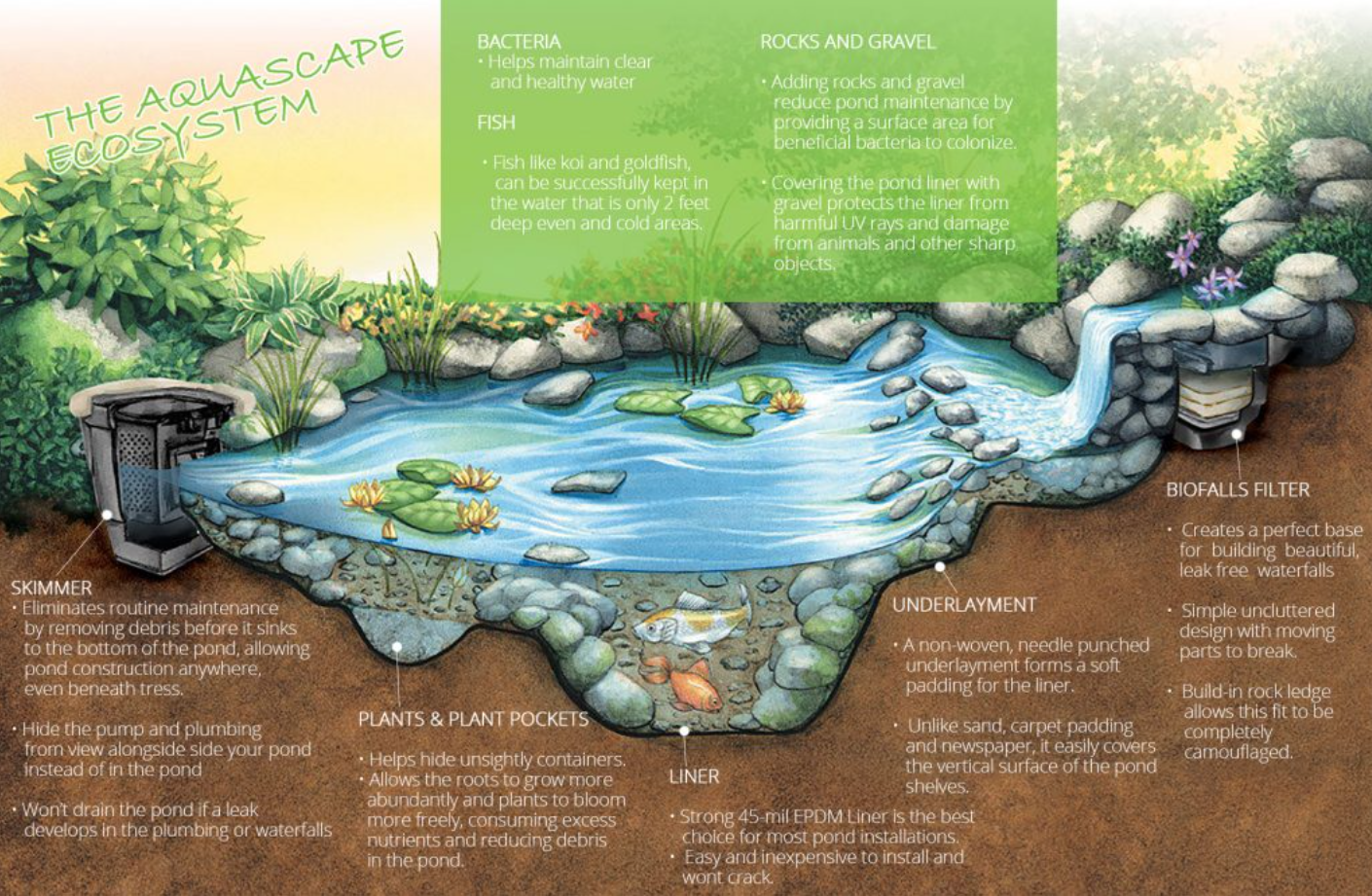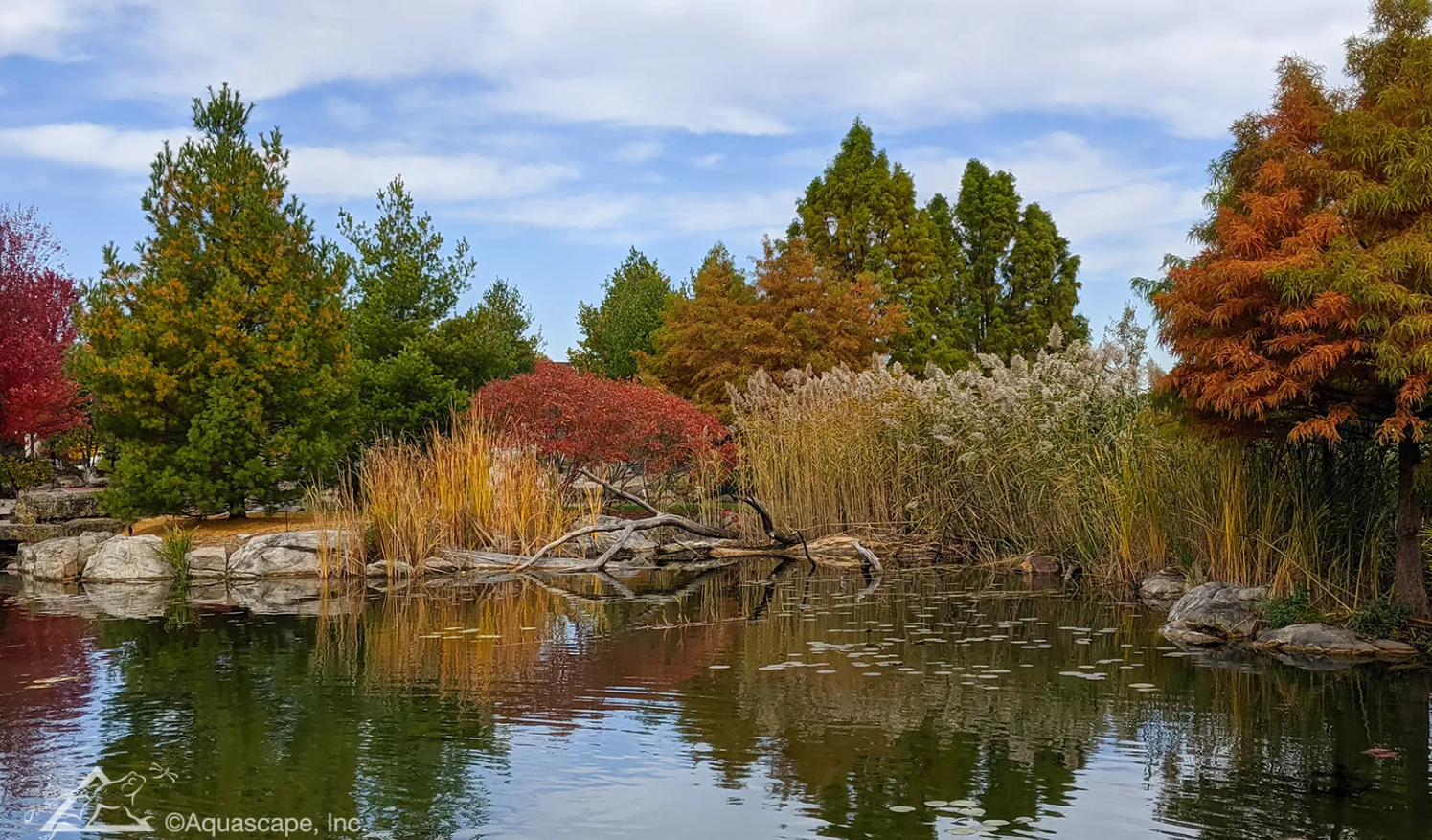Most pond owners already know that good water quality and a healthy pond habitat go hand in hand. However, knowing how to get or to keep high water quality can be challenging to many pond owners. A bit of basic knowledge will help you keep your pond looking beautiful and performing optimally throughout the season.
In addition to plants, fish, aeration, and gravel, a low-maintenance ecosystem pond requires adequate filtration to keep the water clean. There are three types of pond filters currently available on the market which are biological, mechanical, and clarifying filters. Biological filters use bacteria to break down pond wastes, converting them into less harmful compounds that can be used as aquatic plant fertilizers. Mechanical filters trap and remove debris and sediment. Water clarifiers pass pond water through a tube that houses an ultraviolet bulb, killing living microscopic particles in the water.
A proper filtration system consists of separate mechanical and biological filters and is the most effective way to filter pond water. With adequate biological and mechanical filtration, the need for water clarifiers is eliminated altogether, ensuring a fully functioning and natural ecosystem pond.
Mechanical Filtration
The main function of the pond skimmer is mechanical filtration. The skimmer’s job is to remove debris before it sinks to the bottom of the pond and decays. A secondary function of the skimmer is to hide the pump and plumbing connections to your pond while making them easily accessible for maintenance.
A box skimmer is the predominant type of skimmer on the market today because it’s easy to maintain and more effective than a floating skimmer.
Box skimmers come with either vertical or horizontal filter mats. Horizontal mats prove to be the most effective, while providing the least amount of maintenance. In addition to frequent cleaning, vertical mats need to be constantly monitored to make sure there is enough water in the pump chamber for the pump to operate properly. An advantage of horizontal filter mats is that they lay flat so there is no sagging and they don’t lose their shape. They also never clog to the point of preventing water from passing through, so the pump chamber won’t run dry.
As water enters the skimmer, large debris is caught in the skimmer basket and the water is then further filtered through the horizontal mat which removes smaller debris such as seed pods and clumps of algae. The pond water then travels through the plumbing buried underground, up to the biological filter where it’s further treated before re-entering the pond.

Biological Filtration
The biological filter receives water that has already passed through the skimmer. The water enters the biological filter via a flexible pipe located at the bottom of the filter. The water then flows from the bottom to the top of the filter and travels through multiple layers of filter media to remove fine and medium sized particles.
As the biological filter fills, water will overflow the filter’s edge and cascade down rocks that have been set to create a beautiful, natural-looking waterfall. The waterfall creates aeration for the pond, assisting in the circulation and health of the water
Biological filters on the market today range in size and can filter ponds up to 10,000 gallons. For larger ponds, wetland filters can be incorporated into the design.

The Science
Mechanical and biological filtration are critical to processing the many types of nutrients found in a pond ecosystem, including fish waste, uneaten fish food, leaves, and runoff from lawns. A high ammonia level is toxic to fish and a major contributor to algae growth, so it needs to be carefully controlled through biological filtration.
In biological filtration, nitrifying bacteria ultimately convert ammonia to nitrates, which is less dangerous. Nitrifying bacteria require oxygen to synthesize, so it’s important for the pond pump to run at all times. If the pump isn’t running, aeration is eliminated from the process and a healthy pond cannot be maintained. Keep in mind that if the pump shuts down, the healthy bacteria will quickly use up all of the oxygen and die.
Nitrates are then removed from the pond by another biological filtration method known as denitrification. This process occurs under the gravel in the bottom of your pond and in anoxic conditions. The bacteria that live in this area of the pond turn nitrates into nitrogen gas, which is released into the atmosphere. Nitrates are also absorbed by aquatic plants and algae during their growth processes. A pond without aquatic plants will prove to be a maintenance nightmare.
For biological filtration to work effectively there will be billions of healthy bacteria working together to purify the water. These bacteria need to anchor onto things, which is why surface area from rocks and gravel in your pond is so important. More surface area means more bacteria, and more bacteria means better biological filtration.
Aquatic Plants
Another important component to pond filtration is the use of plants. Many gardeners add a pond to their landscape for the variety of aquatic plants available, and while their beauty is certainly an aesthetic asset, a critical benefit is the work these plants do to help filter the water. Plants help purify pond water by reducing nutrients, filtering out sediments and absorbing toxic compounds through the process of phytoremediation.
If these excess nutrients are not removed, algae will feed on them, resulting in green water, string algae, or both. Algae control is not the only way plants help create a low-maintenance ecosystem pond. Submerged and marginal plants also provide food, shade, and protection for the fish and other wildlife that live in and around the pond.

Everything Works Together
To keep pond water quality high, the simple process of repeatedly turning the water over through the mechanical and biological filters is needed in order to create a naturally balanced, low-maintenance ecosystem pond. Add the remaining components of plants, fish, aeration, rock, and gravel, and you’ll find greater success in maintaining clean and clear pond water.
Your fish are happier and less stressed when their environment is healthy. Not to mention, it’s so much more enjoyable when you can actually see your fish swimming in clean water created by an efficient pond filtration system.

